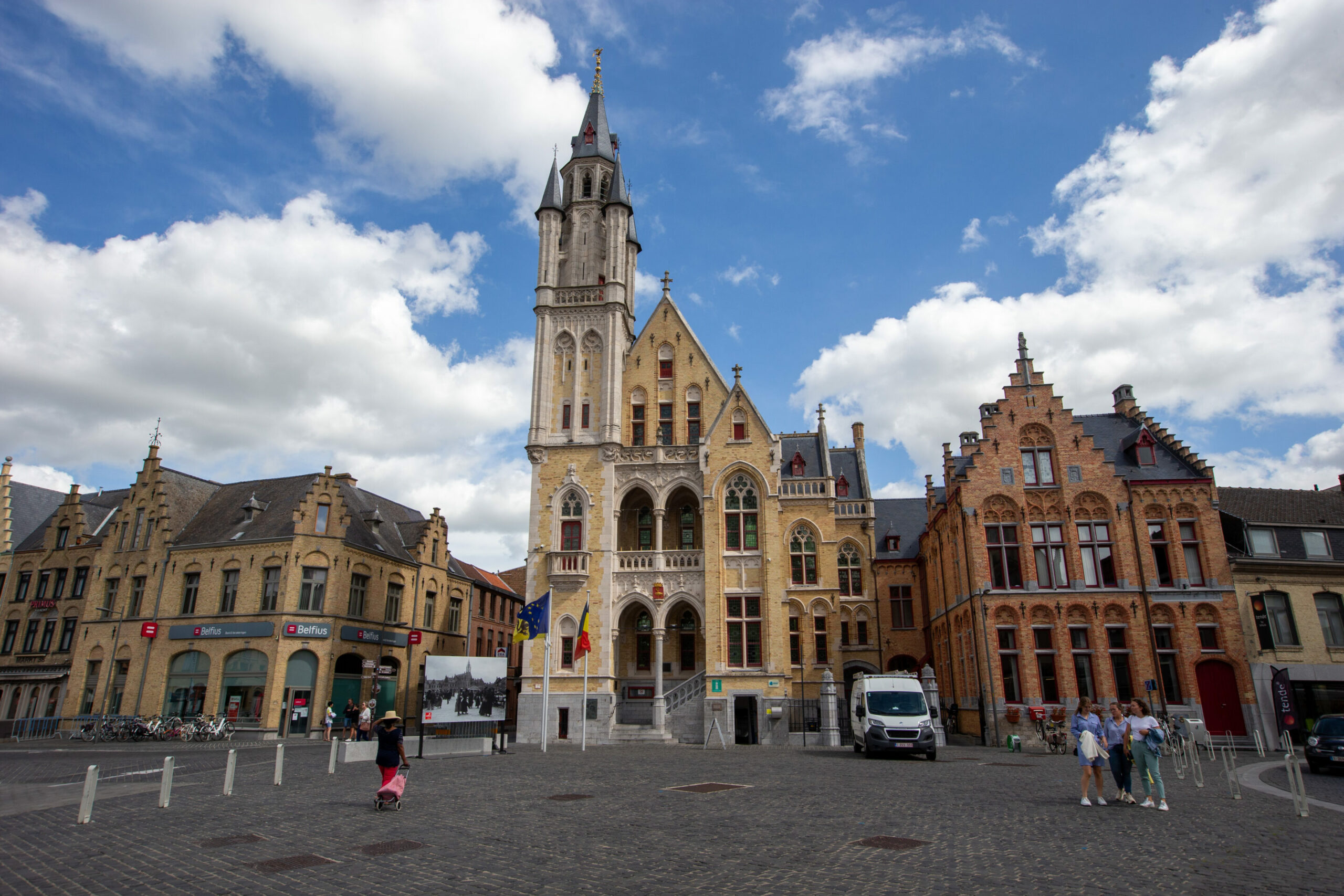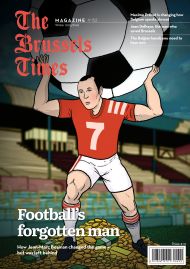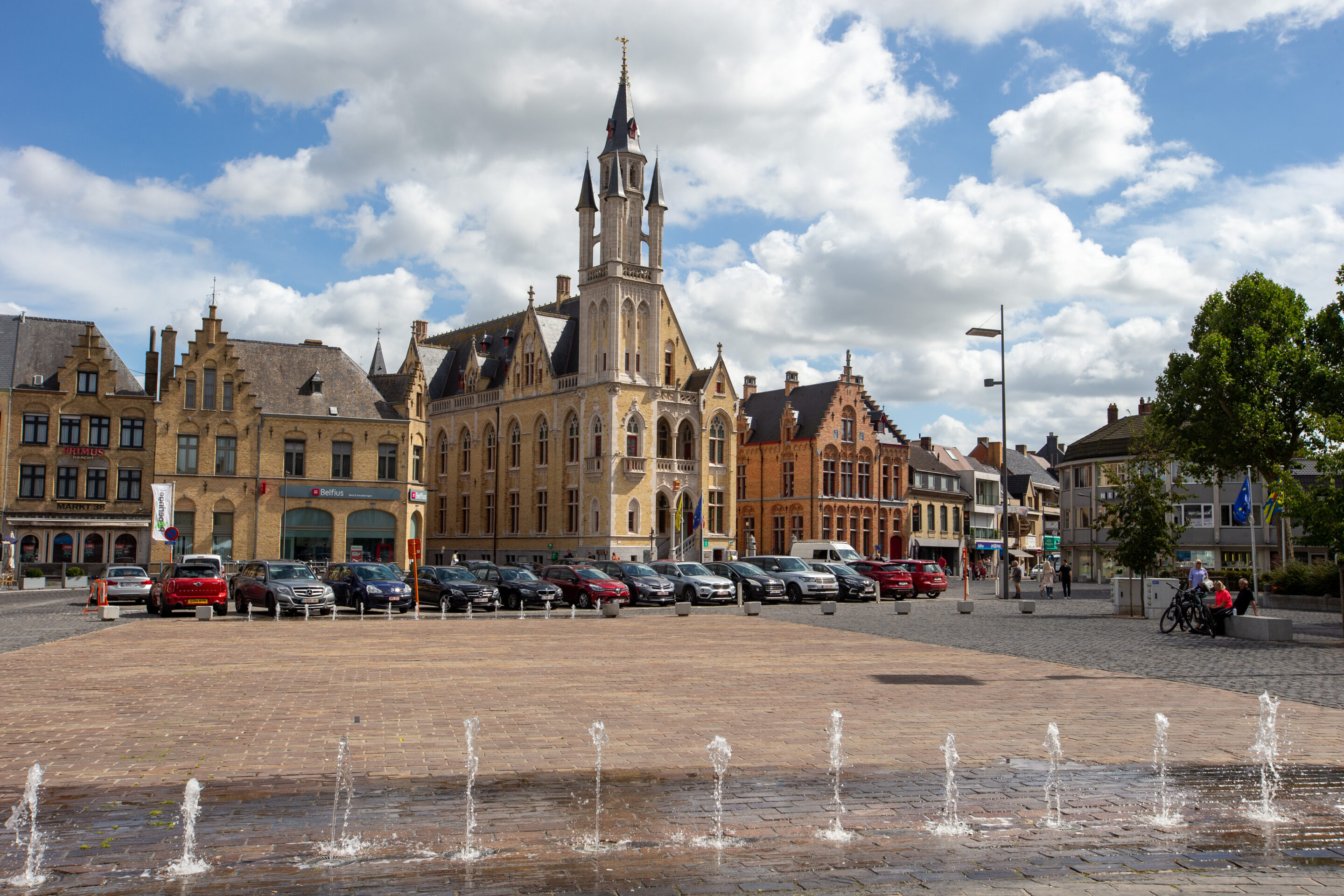Poperinge in West Flanders is Belgium’s hub for hops from farms to beers with a gastronomy scene to match. Near the front lines during World War I, it was well known to British soldiers, who nicknamed it 'Pop'.
Poles define Poperinge, symbolising both life and death from hops crops to First World War executions. Wooden poles support hop vines tied onto wires in nearby fields, growing up to seven metres high. A very different type of pole in the town hall courtyard was a pillory where war deserters were killed.
Poperinge had a bustling textile industry in the Middle Ages, but in 1322 the Count of Flanders forbade cloth-making outside of Ypres. This shifted Poperinge’s economy from textiles to hops (flowers or cones of the female hop plant used in bittering, flavouring and stabilising beer). Hops became big business, and several surviving mansions and former warehouses are a testament to this hoppy time. In recent decades, major breweries and restaurants have sprung up in the hop-growing area, known as Hoppeland.
One of a few Belgium towns unoccupied in during World War I, Poperinge was a refuge for British troops away from combat and a burial site for thousands of soldiers killed in this war. Good ol’ Pop, as British soldiers called it, retains remnants of their influence. Pop was not so lucky in World War II: the German army occupied the town and also left its mark.
Hop stops
Some 20 growers manage 160 hectares of hop fields in and near Poperinge, which includes the town centre and six villages. Together they account for 80% of Belgian hops production. Hop farms Belhop, Humulus and ‘t Hoppecruyt offer guided tours that end with a beer tasting.
The tours are influenced by the seasons from the harvesting of hop shoots in the spring to cones in the fall. Belhop’s beer, Saison Lokaal, uses 100% local hops. Humulus in Vleteren, named after the scientific hop plant name Humulus lupulus, also offers hop shoot harvesting demos from early March to mid-April and hop vine-weaving workshops from late-September to mid-November. Every Saturday afternoon in March, 't Hoppecruyt in Proven explains how hop shoots are grown.
Nutty-tasting hop shoots are known as the white gold of Poperinge and are eaten as a delicacy in Belgium during their six-week growing season. Several Poperinge restaurants serve them. Beer made with Belgian hops is denoted as such by four-colour 50% and gold 100% labels.
The multi-story Hop Museum presents the history of hops in Pop, including cultivation, harvesting and processing, with an optional audio guide. Around 2,500 Belgian beers are displayed in glass cabinets. The museum is free the first Sunday of each month, including guided tours (11 am and 2:30 pm) and other activities, such as a beer tasting or wagon ride through hop fields. On March 1 and 2, visitors can taste beers made with local hops and crunchy hop shoots. A handful of days a year, Hop Museum Brewer Hans Vandepitte invites visitors to help him brew beer from milling and mashing to bottling.
Brewery St. Bernardus in the village of Watou 8km from Poperinge is surrounded by its own hops field, which can be viewed from its large rooftop brasserie called Bar Bernard. Its beers are made with 100% local hops. The brewery was founded in 1946 but renovated in 2023 into a high-tech facility. It offers a self-paced audiovisual experience covering the brewery’s history and brewing process, and a behind-the-scenes look at production and beer tasting. St. Bernardus also has an 11-room guesthouse and shop.
Sint-Sixtus Abbey in Westvleteren nine km away is known globally for its beer named after the village. Brewed by the abbey’s Trappist monks since 1839, its beer is often rated as the best ever made. The monks produce limited quantities of four types: Westvleteren 12, 8, 6 and Wit. These hard-to-find beers can be purchased at Trappist Westvleteren, the Sint-Sixtus brewery, only via a lottery system with online registration.
Military mementos
Talbot House, dubbed Every Man’s Club, was set up in 1915 as a clubhouse for British soldiers and nurses of every rank. It was founded by army chaplains Neville Talbot and Philip ‘Tubby’ Clayton, whose life stories are told in a museum and film on site. Talbot House also has a tearoom, bed and breakfast, shop, beautiful garden (which sells rose plants), chapel, temporary exhibition space and concert hall, where ‘Happy Hoppers’ put on a revue show. The clubhouse was occupied by the Germans during World War II, but its contents were hidden by locals beforehand – many of which are displayed today.
In dark contrast, Poperinge’s town hall on the market square (Grote Markt) is a former prison for Allied soldiers who misbehaved or deserted World War I and its courtyard contains an execution pillory that commemorates at least four Commonwealth soldiers who were shot dead there during the war (25 British and two Canadians were executed by firing squad in Poperinge, though not all in this courtyard.) Four prison cells, dating from 1913, housed Allied soldiers for one or more nights due to drunkenness or staying out during prohibited hours. Deserters were sentenced to death and awaited their execution in these cells – two of which were restored for visiting. Some prisoners left their marks via graffiti. In the town park, a remarkable statue called Shot at Dawn, which looks as if it’s been toppled over, honours the unjustly executed soldiers.

The town hall in Poperinge, Thursday 27 August 2020. Credit: Belga / Nicolas Maeterlinck
The Chinese site Busseboom commemorates China’s wartime workers with two monuments, one commissioned by the Chinese Embassy in Brussels and the other by Poperinge’s authorities. They are connected by a footpath and surrounded by 13 topiary trees that represent 13 Chinese workers who died during a bombing of their camp in 1917.
The Exilium memorialises thousands of children evacuated from the Westhoek (southwest Flanders) region during World War I to lace-making schools in France or Switzerland. The shape resembles an auxiliary barrack with lace patterns on wire fencing.
Lijssenthoek Military Cemetery in the hamlet of the same name pays homage to 94 soldiers from the British Air Force – the largest concentration of ‘flyboys’ in a military cemetery – and what was once the largest evacuation hospital in the region from 1915 to 1920. A visitor centre tells about life in the hospital and the rebuilding of the cemetery. It includes hospital diaries, voices from the past, stories and portraits of those buried there, and an immersive experience called Forgotten Track about trains in the area during the war. There is also a musical walk to the song ‘1000 Soldiers’ by Willem Vermandere. Since 2023, the cemetery has been one of 27 World War I memorial sites in Flanders Fields recognised as UNESCO World Heritage.
Poperinge has five military cemeteries: Gwalia, Communal, New Military, Old Military and Nine Elms British Cemetery. In the surrounding area besides Lijssenthoek, there are an additional seven military cemeteries, including Abeele Aerodrome in Abele, Bandaghem in Haringe, Mendinghem in Proven, Dozinghem in Vleteren, Grootebeek British Cemetery in Reningelst, and Reningelst New Military Cemetery and Churchyard. Commonwealth, French, German and US soldiers are buried in these cemeteries.
A former German Observation Tower overlooking Airfield Peselhoek built during World War II is set to open in May 2025 for tourism. On the outskirts of Poperinge, it will offer one of the highest lookout points in the area, including panoramic views of the town. It is belatedly opening in honour of the 80th anniversary of Poperinge’s liberation on September 6, 1944. A memorial plaque on the façade of the town hall recognises this liberation by the 1st Polish Armoured Division. At Provenseweg 47, a large plaque commemorates Flight Sergeant Stacey Jones, who crashed into a nearby house during a dogfight in 1942.
Outdoor adventures
Poperinge and surrounding villages are idyllic for walking, hiking, biking and motorised modes of transportation. Twelve hiking routes from 5.5 to 12km are at ToerismePoperinge.be and via Visit Poperinge in the town hall, including a town walk and several through nature like the Couthof Walk and Sint-Sixtus Walk. The latter goes through the hops landscape plus woods containing roe deer.
Visit Poperinge also suggests several biking routes, including through Hoppeland, beer-related sights, military relics and hill country as well as for mountain biking. Hill country includes the Kemmelberg, the highest point in West Flanders. TourneeLocale.be also has routes from 33-46.5km, including Poperinge-Vleteren (33km), voted the “most beautiful cycling route in Belgium.” The Talbot House offers a ‘Meet Me Where the Poppies Blow’ bike/car route that traces the footsteps of former Chaplain Tubby Clayton, who searched the post-war area for Talbotousians. The route goes past 11 historical sites, each with a podcast via Spotify. Bike rentals are available from Poperinge companies Amfora, Fietsverhuur, Old Fiddler and Blue Bike.
An 87km Front Life car route explores the area between Poperinge and Heuvelland and tells of the Allied victory in the 1917 Mine Battle of Messines and the heinous Allied loss in the 1918 Battle of the Kemmelberg. The route is for sale at Visit Poperinge (Dutch only).
There are also scooter routes, notably a 60km gastronomic tour that goes through the flat countryside of Poperinge and Vleteren. A 110km World War I scooter route also includes Heuvelland, passing military cemeteries, memorials and museums. Vespas can be rented from Vespa-Ride in the village Proven and scooters from J-Fun in Watou and Stal ‘t Bardehof in Krombeke.
Half and full-day covered wagon rides are offered in the Poperinge countryside by 't Wulleminhof, De Poperingse Keikoppenroute (keikoppen means cobblestone heads, a medieval nickname for people from Poperinge), De Schipperkeshoeve and Huifkarren Au Nouveau Saint-Eloi.
Canoeing and kayaking are possible on the Yser River in nearby Roesbrugge on the French border (the village was a key tobacco and alcohol smuggling hub during the World Wars).
Finally, go-carting is possible at Worldkarts for drivers of all levels. This outdoor adventure company also offers quad bikes, paintball and more.
Other experiences
The Lucien De Gheus Museum House is where the Belgian artist lived, which displays several of his artworks. While he was primarily a sculptor and ceramist, he also created stained glass windows, drawings and paintings shown on site. The property includes a beautiful garden and Hones

The city hall in Poperinge, Thursday 27 August 2020. Credit: Belga / Nicolas Maeterlinck
ty Bar. Individuals can visit from mid-May to mid-September without reservation and groups year-round with booked guided tours.
Sint-Bertinus Church on the market square is Poperinge’s oldest church, with its Gothic style dating to around 1420 (it was first built in the 9th century). It has notable carillon bells, sculptures and stained glass windows including hops-picking scenes. Opposite the church on the other side of the square is a brass sculpture of Eliane 'Ginger' Cossey, the most famous waitress of the Allied Western Front whose father owned the then officer’s pub behind it (La Poupée).
The 13th-century Sint-Jans Church is known for a miracle: a stillborn baby was brought back to life there after three days in 1479. An annual procession, Maria Ommegang, has commemorated the miracle on the first Sunday in July for the last 80 years.
Games of yesteryear, including feather bowling, uilebolling, billard aerobille, boltra, marbles, spillikins, shuffleboard and more, can be played via a Folk Sports Route in a dozen bars and eateries. Booking at volkssportroute.be must be done at least three weeks in advance for a minimum of 10 adults.
De Galge (Gallows) is a striking brick construction composed of three, connected minarets sitting in Couthofbos (Woods) in Watou. Oddly named, it never had anything to do with hanging criminals.
The World War I battleground of Ypres is 13km east of Poperinge. While called the Town of Cats, it is better known for its military history and outstanding World War I museum In Flanders Fields. The Last Post, a salute by buglers of the Last Post Association, occurs daily at 8pm under the Menin Gate Memorial to the Missing in honour of the Allied soldiers who died in the Ypres Salient during the war. Twelve of the 27 UNESCO World Heritage sites in Flanders pertaining to World War I are in Ypres, all of which are cemeteries except Menin Gate.
Experience
Arts Festival Watou: A two-month summertime event featuring visual arts and poetry in unusual spaces. In 2025, 10 paintings will be hidden in Poperinge municipality that finders get to keep!
Beer & Hop Festival: Every three years the third weekend of September. (next in 2026), the hops crop is honoured, even with a queen
Brouw Workshop: Several times a year (March 8, April 12, Oct 11 and Nov 15), an all-day brewing workshop at the Hop Museum including coffee, lunch and beer. Also available on demand by private groups.
Lekker Westhoek: Every three years the third weekend in Sept (next Sept 20-21, 2025), a two-day beer-tasting festival featuring brews made with Belgian hops from 20 breweries
Taste of Hops: Four days every three years (next March 22, 24, 27, 29 2025) featuring a 20km bike tour, stop at ‘T Hoppecruyt farm to see hop shoots harvesting, lunch including hop shoots and Westvleteren beer tasting at Sint-Sixtus Abbey
Winter in Poperinge: Annual festival from mid-Dec to early Jan including an indoor Christmas market, covered skating rink, carousel, Warm Winter Walk, Hoppeland Light Run and entertainment
Savour
Goeste: A tasty, cosy restaurant and tearoom on the market square featuring local products, including its own ice cream and hops syrup
Hartig: Focused on beef with a chef the son of a butcher, this upscale restaurant offers a monthly menu and weekly lunch
La Paix: An upscale restaurant on the town’s market square in a hotel of the same name featuring local ingredients and Belgian-inspired cuisine
Pegasus: In Hotel Recour, this gastronomic restaurant is known for fine cuisine and a romantic atmosphere
't Blauwers Huys: “Uncomplicated, authentic and timeless” per the owners, this bistro offers everything from local beers and bites up to a feast
Sip & snack
Au Nouveau St.-Eloi: A café in Watou with 150+ beers, farmhouse platters, seasonal specials, Flemish folk games, terrace and horse-drawn wagon rides over the French border
Bar Bernard: An indoor-outdoor brasserie at St. Bernardus Brewery in Watou overlooking a hops field that offers beer tastings and snacks
Café De Stadsschaal: A restored, authentic pub in front of the Hop Museum offering local beers and traditional Flemish games
Café Helleketel: Overlooking hops fields, this old establishment offers homemade Picon, farmhouse platters, traditional games and covered wagon rides upon request
La Poupée: Meaning “The Doll” in French, a stylish tearoom on Poperinge’s market square that used to be a World War I officer’s pub where the owner’s daughter “Ginger” was known for her hospitality
Stay
De Rentmeesterhoeve: A luxury bed and breakfast in the former castle of Reningelst with seven spacious, modern rooms – each including a fireplace – private parking and scooter rental
Hotel de la Paix: On Poperinge’s market square, this boutique hotel has five stylish rooms with great views (two have a rooftop terrace) and an upscale restaurant
Hotel Manoir Ogygia: A four-star, charming boutique hotel with 10 stylish rooms, including breakfast, a swimming pool, spa, restaurant and terrace
Hotel Recour: A four-star, luxury hotel with seven rooms, a gastronomic restaurant and garden near Poperinge’s market square
Talbot House: A quaint bed and breakfast within a historic soldier’s clubhouse offering seven rooms, English breakfast and free access to the on-site museum
Shop
Cœur au Chocolat: Chocolatier selling pralines, bars, confections, candy cakes and regional products
Goeste: Features regional food products from local beers to hop shoot liqueur as well as homemade ice cream located across from the restaurant of the same name
Stefan’s Pottery: Located in Roesbrugge-Haringe, a store in the workshop of potter Stefan Ferlin that sells vases, tea sets, bowls and more
St. Bernardus: Offers all beer produced by this acclaimed brewery as well as gift sets, glasses, clothing and other branded items
Weekly Friday Market: Every Friday from 08:30 to 12:00 on the market square featuring local vendors with farm-fresh products




